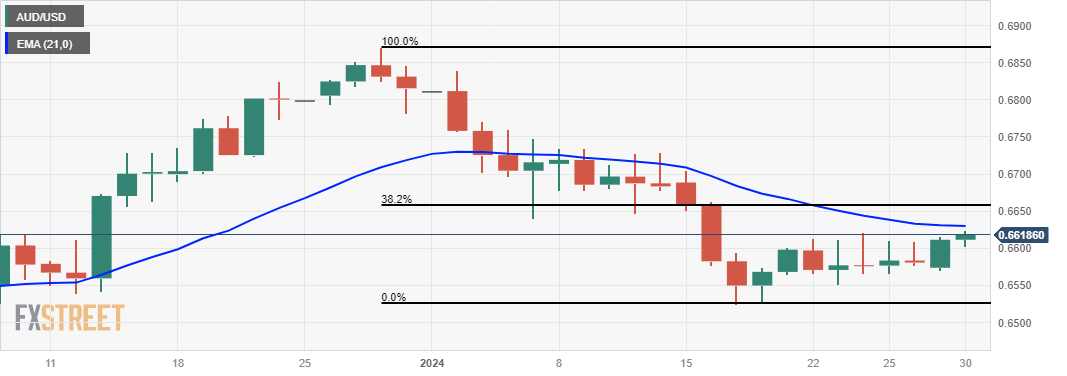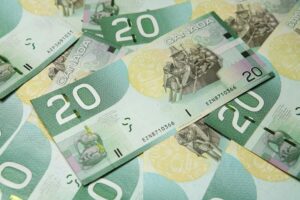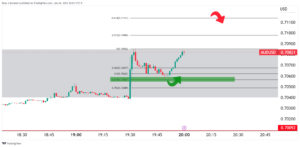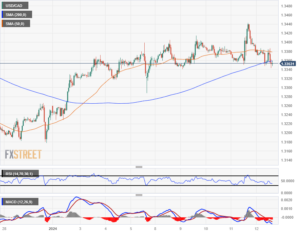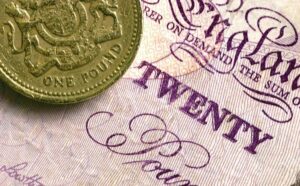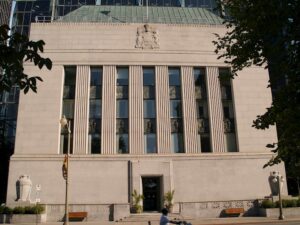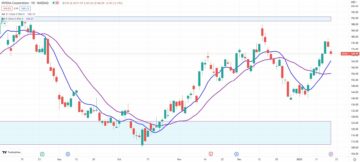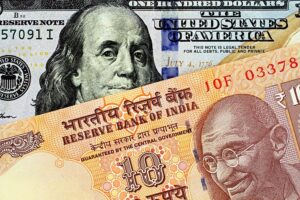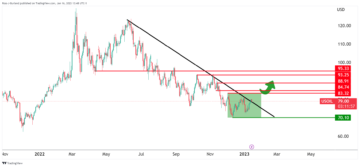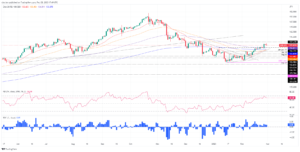- Australian Dollar appreciates for the second straight session amid a stable US Dollar.
- Australia's Retail Sales (MoM) declined by 2.7% in December against the expected fall of 0.9% and the previous growth of 2.0%.
- US Dollar faced a challenge on lower US yields due to the healthier US balance sheet.
- US Treasury Department plans to borrow $760 billion in Q1 lower than the previous estimate of $816 billion in October.
The Australian Dollar (AUD) continues to gain ground on Tuesday amid a stable US Dollar (USD). The AUD/USD pair received upward support as United States (US) bond yields declined in the previous session, a trend attributed to the healthier US balance sheet. Since October 2023, the decrease in yields has contributed to the sustainability of the US Treasury, and stronger economic growth has led to improved tax receipts. The US Treasury Department recently announced plans to borrow $760 billion in the first quarter, which is lower than the previous estimate of $816 billion in October.
Australia's Bureau of Statistics released the seasonally adjusted Retail Sales (MoM) for December on Tuesday, indicating a decline of 2.7%. This figure contrasted with the expected fall of 0.9% and marked a notable reversal from the previous growth of 2.0%. Surprisingly, the Aussie Dollar (AUD) strengthened despite the release of disappointing consumer spending data. The AUD's resilience could be attributed to positive sentiments stemming from news about additional stimulus measures in China, consequently motivating the AUD/USD pair. Furthermore, the Australian Consumer Price Index (CPI) data will be eyed on Wednesday, which is expected to decline by 0.8% in the fourth quarter from 1.2% prior.
The US Dollar Index (DXY) shows stability after experiencing losses on Monday, attributed to improved US Treasury yields. The risk aversion sentiment could intensify as the administration of US President Joe Biden is anticipated to authorize military strikes in response to the recent drone attack on a US outpost in Jordan, resulting in the death of three US troops and injuries to at least 24.
Investors will closely monitor the Federal Open Market Committee (FOMC) statement scheduled for Wednesday, January 31. The consensus expectation is that the Fed Funds rate will remain unchanged at 5.25-5.50%. However, the prevailing market bias toward a potential rate cut in March may exert downward pressure on the US Dollar (USD). Ahead of the FOMC statement, Tuesday's releases of the Housing Price Index and Consumer Confidence figures will be closely watched for further insights into the market.
Daily Digest Market Movers: Australian Dollar advances amid a stable US Dollar
- Australia's Manufacturing PMI increased from 47.6 to 50.3, showcasing improvement. Services PMI also saw an uptick, rising from 47.1 to 47.9. The Composite PMI registered an increase, reaching 48.1 compared to December's 46.9.
- The Reserve Bank of Australia’s (RBA) Bulletin has indicated that over the past six months, businesses generally expect a moderation in their price growth, with prices anticipated to remain above the RBA's inflation target range of 2.0–3.0%.
- Chinese financial media reported that the People's Bank of China (PBoC) may cut the Medium-term Lending Facility (MLF) rate in the current quarter. The announcement follows the recent statement by PBoC Governor Pan Gongsheng, who revealed that the Bank would reduce the Required Reserve Ratio (RRR) by 50 basis points starting from February 5th.
- US Core Personal Consumption Expenditures Price Index (PCE) for December showed a 0.2% monthly increase, in line with expectations, compared to 0.1% in the previous reading. The yearly Core PCE rose 2.9%, falling short of the 3.0% expected and the previous reading of 3.2%.
- The US Gross Domestic Product Annualized (Q4) reported a reading of 3.3% against the previous reading of 4.9%, exceeding the market consensus of 2.0%.
Technical Analysis: Australian Dollar moves above the psychological level of 0.6600
The Australian Dollar trades around 0.6620 on Tuesday, encountering initial resistance at the 21-day Exponential Moving Average (EMA) at 0.6629 followed by the key resistance level at 0.6650. A firm breakthrough above the resistance level could improve the sentiment for the AUD/USD pair to surpass the 38.2% Fibonacci retracement level at 0.6657 following the psychological barrier at 0.6700. On the downside, the AUD/USD pair could find immediate support at the psychological level at 0.6600. A break below the latter could push the pair to revisit the previous week's low at 0.6551, aligning with the significant level at 0.6550. The pair could retest the monthly low at 0.6524 if this support is breached.
AUD/USD: Daily Chart
Australian Dollar price today
The table below shows the percentage change of Australian Dollar (AUD) against listed major currencies today. Australian Dollar was the strongest against the Pound Sterling.
| USD | EUR | GBP | CAD | AUD | JPY | NZD | CHF | |
| USD | -0.01% | 0.03% | -0.04% | -0.06% | -0.09% | -0.02% | 0.02% | |
| EUR | 0.01% | 0.03% | -0.02% | -0.06% | -0.09% | -0.01% | 0.01% | |
| GBP | -0.03% | -0.03% | -0.06% | -0.09% | -0.12% | -0.04% | -0.01% | |
| CAD | 0.04% | 0.05% | 0.07% | -0.03% | -0.06% | 0.02% | 0.05% | |
| AUD | 0.07% | 0.07% | 0.10% | 0.03% | -0.03% | 0.05% | 0.08% | |
| JPY | 0.09% | 0.10% | 0.13% | 0.05% | 0.02% | 0.07% | 0.10% | |
| NZD | 0.02% | 0.01% | 0.05% | -0.02% | -0.04% | -0.07% | 0.02% | |
| CHF | -0.02% | -0.02% | 0.02% | -0.04% | -0.07% | -0.10% | -0.02% |
The heat map shows percentage changes of major currencies against each other. The base currency is picked from the left column, while the quote currency is picked from the top row. For example, if you pick the Euro from the left column and move along the horizontal line to the Japanese Yen, the percentage change displayed in the box will represent EUR (base)/JPY (quote).
Australian Dollar FAQs
One of the most significant factors for the Australian Dollar (AUD) is the level of interest rates set by the Reserve Bank of Australia (RBA). Because Australia is a resource-rich country another key driver is the price of its biggest export, Iron Ore. The health of the Chinese economy, its largest trading partner, is a factor, as well as inflation in Australia, its growth rate and Trade Balance. Market sentiment – whether investors are taking on more risky assets (risk-on) or seeking safe-havens (risk-off) – is also a factor, with risk-on positive for AUD.
The Reserve Bank of Australia (RBA) influences the Australian Dollar (AUD) by setting the level of interest rates that Australian banks can lend to each other. This influences the level of interest rates in the economy as a whole. The main goal of the RBA is to maintain a stable inflation rate of 2-3% by adjusting interest rates up or down. Relatively high interest rates compared to other major central banks support the AUD, and the opposite for relatively low. The RBA can also use quantitative easing and tightening to influence credit conditions, with the former AUD-negative and the latter AUD-positive.
China is Australia’s largest trading partner so the health of the Chinese economy is a major influence on the value of the Australian Dollar (AUD). When the Chinese economy is doing well it purchases more raw materials, goods and services from Australia, lifting demand for the AUD, and pushing up its value. The opposite is the case when the Chinese economy is not growing as fast as expected. Positive or negative surprises in Chinese growth data, therefore, often have a direct impact on the Australian Dollar and its pairs.
Iron Ore is Australia’s largest export, accounting for $118 billion a year according to data from 2021, with China as its primary destination. The price of Iron Ore, therefore, can be a driver of the Australian Dollar. Generally, if the price of Iron Ore rises, AUD also goes up, as aggregate demand for the currency increases. The opposite is the case if the price of Iron Ore falls. Higher Iron Ore prices also tend to result in a greater likelihood of a positive Trade Balance for Australia, which is also positive of the AUD.
The Trade Balance, which is the difference between what a country earns from its exports versus what it pays for its imports, is another factor that can influence the value of the Australian Dollar. If Australia produces highly sought after exports, then its currency will gain in value purely from the surplus demand created from foreign buyers seeking to purchase its exports versus what it spends to purchase imports. Therefore, a positive net Trade Balance strengthens the AUD, with the opposite effect if the Trade Balance is negative.
- SEO Powered Content & PR Distribution. Get Amplified Today.
- PlatoData.Network Vertical Generative Ai. Empower Yourself. Access Here.
- PlatoAiStream. Web3 Intelligence. Knowledge Amplified. Access Here.
- PlatoESG. Carbon, CleanTech, Energy, Environment, Solar, Waste Management. Access Here.
- PlatoHealth. Biotech and Clinical Trials Intelligence. Access Here.
- Source: https://www.fxstreet.com/news/australian-dollar-maintains-its-positive-trajectory-despite-a-downbeat-aussie-retail-sales-202401300140
- :has
- :is
- :not
- $UP
- 1
- 16
- 2%
- 2021
- 2023
- 24
- 31
- 32
- 35%
- 36
- 41
- 46
- 50
- 5th
- 9
- a
- About
- above
- According
- Accounting
- Additional
- Adjusted
- adjusting
- administration
- advances
- After
- against
- aggregate
- ahead
- aligning
- along
- also
- Amid
- an
- analysis
- and
- Animate
- announced
- Announcement
- annualized
- Another
- Anticipated
- ARE
- around
- AS
- Assets
- At
- attack
- AUD
- AUD/USD
- aussie
- Australia
- Australian
- Australian dollar
- authorize
- average
- Balance
- Balance Sheet
- Bank
- Bank of China
- Banks
- barrier
- base
- basis
- BE
- because
- below
- between
- bias
- biden
- Biggest
- Billion
- bond
- Bond yields
- borrow
- Box
- Break
- breakthrough
- bulletin
- Bureau
- businesses
- buyers
- by
- CAN
- case
- central
- Central Banks
- challenge
- change
- Changes
- China
- chinese
- closely
- Column
- committee
- compared
- conditions
- confidence
- Consensus
- Consequently
- consumer
- consumption
- content
- continues
- contributed
- Core
- could
- country
- CPI
- created
- credit
- currencies
- Currency
- Current
- Cut
- daily
- data
- Death
- December
- Decline
- decrease
- Demand
- Department
- Despite
- destination
- difference
- Digest
- direct
- disappointing
- displayed
- doing
- Dollar
- dollar index
- Domestic
- down
- downside
- downward
- driver
- drone
- due
- Dxy
- each
- easing
- Economic
- Economic growth
- economy
- effect
- EMA
- encountering
- ends
- estimate
- EUR
- Euro
- example
- expanded
- expect
- expectation
- expectations
- expected
- experiencing
- exponential
- exponential moving average
- export
- exports
- faced
- Facility
- factor
- factors
- Fall
- Falling
- falling short
- Falls
- FAQ
- FAST
- February
- Fed
- fed funds rate
- Federal
- Federal Open Market Committee
- Figure
- Figures
- financial
- Find
- Firm
- First
- followed
- following
- follows
- FOMC
- For
- foreign
- Former
- Fourth
- from
- from 2021
- funds
- further
- Furthermore
- Gain
- generally
- goal
- Goes
- goods
- Governor
- greater
- gross
- Ground
- Growing
- Growth
- Have
- Health
- healthier
- High
- higher
- highly
- Horizontal
- housing
- However
- HTTPS
- if
- immediate
- Impact
- imports
- improve
- improved
- improvement
- in
- Increase
- increased
- Increases
- index
- indicated
- indicating
- inflation
- inflation rate
- influence
- initial
- insights
- interest
- Interest Rates
- into
- Investors
- IT
- ITS
- January
- Japanese
- Japanese Yen
- joe
- Joe Biden
- Jordan
- Key
- key resistance
- largest
- least
- Led
- left
- LEND
- lending
- Level
- lifting
- likelihood
- Line
- Listed
- losses
- Low
- lower
- Main
- maintain
- maintains
- major
- manufacturing
- map
- March
- marked
- Market
- market sentiment
- materials
- May..
- measures
- Media
- Military
- MLF
- moderation
- module
- mom
- Monday
- Monitor
- monthly
- months
- more
- most
- move
- Movers
- moves
- moving
- moving average
- negative
- net
- news
- notable
- october
- of
- often
- on
- open
- opposite
- or
- Other
- over
- pair
- pairs
- PAN
- partner
- past
- pays
- PBOC
- pce
- People
- People's Bank of China (PBoC)
- percentage
- personal
- pick
- picked
- plans
- plato
- Plato Data Intelligence
- PlatoData
- pmi
- points
- positive
- potential
- pound
- pound sterling
- president
- president joe biden
- pressure
- previous
- price
- Prices
- primary
- Prior
- produces
- Product
- psychological
- psychological barrier
- purchase
- purchases
- purely
- Push
- Pushing
- Q1
- quantitative
- Quantitative Easing
- Quarter
- quote
- range
- Rate
- Rates
- ratio
- Raw
- RBA
- reaching
- Reading
- receipts
- received
- recent
- recently
- reduce
- registered
- relatively
- release
- released
- Releases
- remain
- Reported
- represent
- required
- Reserve
- reserve bank
- reserve bank of australia
- Reserve Bank of Australia (RBA)
- resilience
- Resistance
- response
- result
- resulting
- retail
- Retail Sales
- retracement
- Revealed
- Reversal
- Rises
- rising
- Risky
- ROSE
- ROW
- s
- sales
- saw
- scheduled
- Second
- seeking
- sentiment
- sentiments
- Services
- session
- set
- setting
- sheet
- Short
- showcasing
- showed
- Shows
- significant
- since
- SIX
- Six months
- So
- sought
- Spending
- Stability
- stable
- Starting
- starts
- Statement
- States
- statistics
- sterling
- stimulus
- straight
- strengthened
- Strengthens
- Strikes
- stronger
- strongest
- support
- surpass
- surplus
- surprises
- Sustainability
- table
- taking
- Target
- tax
- tend
- than
- that
- The
- the Fed
- their
- then
- therefore
- this
- three
- tightening
- to
- today
- top
- toward
- trade
- trades
- Trading
- trajectory
- treasury
- Treasury Department
- Treasury yields
- Trend
- Tuesday
- United
- United States
- upward
- us
- US Dollar
- US Dollar Index
- US President
- US Treasury
- Us Treasury Department
- US treasury yields
- US yields
- USD
- use
- value
- Versus
- was
- Wednesday
- week
- WELL
- What
- when
- whether
- which
- while
- WHO
- whole
- will
- with
- would
- year
- yearly
- Yen
- yields
- you
- zephyrnet

